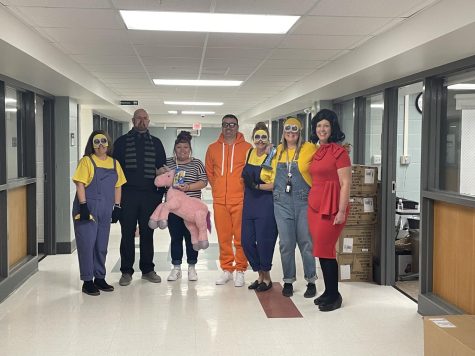COT restores decrepit home
Biddeford COT restores a home that the city of Biddeford gave to add to the learning experience
April 1, 2016
Students come together to recreate the former glory the home once held, no matter, rain, sunshine, or even the weekend.
In September of 2015, the city of Biddeford gave the Center of Technology (COT) a property located on Main Street. Students from the Buildings Trade program work to rejuvenate the abandoned home .
According to the buildings and trade teacher Wayne Hapgood, several students from BHS and Old Orchard Beach volunteered on a Saturday morning to help demolish the chimney in the house.
“The Biddeford, Saco Rotary has done the lion’s share of the work so far in terms of demolition,”said Hapgood. “The Building Trades program has spent some time salvaging fir flooring to be reused in the finished project and some light demolition.”
According to Hapgood, the house is a place to learn useful skill that will help students in the future.
“The goal is to provide various opportunities throughout the project life span that will enable students to further develop their practical residential construction skills,” Hapgood said.
With dangerous projects like the house, a major concern of both parents and administration is safety, and luckily they don’t need to worry since safety while using specific tools and equipment.
“Safety is a huge priority,” said Hapgood. “Safety is the first thing taught in the program and is reinforced with every unit.”
The COT Building Trades Program has worked in partnership with the Biddeford, Saco Rotary for over 40 years.
“ They have provided funding for students to build a range of projects from sheds to houses,” said Hapgood. “Completed projects are sold in the community to sustain the funding for future projects.”
Along with many other projects the program has completed locally, the house on Main Street is one that will be remembered due to it’s complexity.
“There are certain aspects of residential construction a first year student can be involved in,” said Hapgood. “Other aspects would require training beyond High School.”
According to Hapgood, all of the skills needed in the house are taught in the classroom beforehand.
“Any project component the program takes on is supported by the appropriate theory, classroom lessons and training,” Hapgood said.
Sophomore Nate Turbide, joined the program to learn more about carpentry to ultimately work beside his father.
“My father was in the trade and I wanted to work with him during the summers,” Turbide said.
Students like Turbide, worked to make the house not only look nice as a finished product, but also to have good quality put into it as well.
“We tore up some floor boards that we plan to reuse, and we also did a lot of demolition on the structure.The biggest one being taking down the chimney, and some walls,” said Turbide. “Thanks to the Biddeford-Saco Rotary Club, we had this awesome opportunity.”
Some students like Turbide go into the program to follow a parent’s footsteps, while others try to find what interests them as a possible career path.
“My father, being in the trade, really made me want to do this,” said Turbide. “I really hope to be in carpentry when I’m older.”
Peeking student’s interests and helping to figure out what students may want to pursue is a main goal at the Center of Technology.
“This class has helped me decide on what I want to be when I get older,” said Turbide. “At first I was skeptical but now I know for sure that I want to go into the field of carpentry.”
Senior Nick Phillips signed up for the class because he thought it may interest him, and he helped rip up some of the flooring along with a door header.
“I don’t want to work in construction,” said Phillips. “The class helped me notice that I would do anything other than construction.”
Compared to the usual things the Building Trade department gets to use to teach students, the house on Main Street allows students to see the process on how things are built.
“The house is from the early 1900s, and it’s a very cool way to learn construction,” said Phillips. “You get to see how everything was installed, the different type of hardware, and the way it has evolved since that house was made.”









